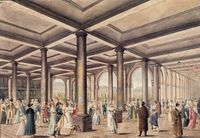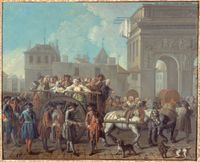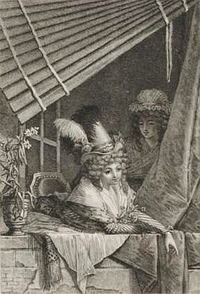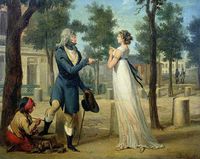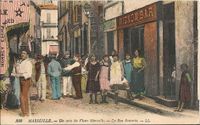Prostitution in France
|
|
Prostitution in France (the exchange of sexual acts for money) was legal until April 2016, but several surrounding activities were illegal, like operating a brothel, living off the avails (pimping), and paying for sex with someone under the age of 18 (the age of consent for sex is 15).
On 6 April 2016, the French National Assembly voted to punish customers of prostitutes by a fine of €1,500.
In the Napoleonic era, France became the model for the regulatory approach to prostitution. In the 20th century, however, a policy shift became apparent. Brothels became illegal in 1946, and France signed the Convention for the Suppression of the Traffic in Persons and of the Exploitation of the Prostitution of Others ↗ in 1960, thus becoming a major supporter of the international abolitionist movement for the eradication of prostitution.
History
- Wikipedia article: History of prostitution in France
The history of prostitution in France is similar to that in other European countries, with alternating periods of tolerance and repression (Tolérance générale, répression occasionnelle), but is marked by the length of time during which the maisons (brothels) were tolerated. Prostitutes were not marginalized, but integrated into society where they had a role to play. In stories (which were often ribald), prostitutes would be complicit with other women in avenging men. The great Cathedral of Chartres had a window endowed by prostitutes (The Prodigal Son) in the same way as other windows were endowed by various other trade guilds (The Trade Windows).
Early period
After the period of Roman rule, the Visigoth monarch Alaric II (485–507 AD) seems to be the first French ruler to prosecute prostitution.
Middle Ages
During the Middle Ages, the various authorities, civil or noble, oversaw prostitution as an institution. Regulation was largely at the municipal level, restricting activity on certain streets, travel, liaisons, required distinctive dress (gold belts, or ceinture dorée) and opening hours of the maisons (10–6, or 10–8 in Paris).
Charlemagne (768–814 AD) was amongst those rulers who attempted to suppress prostitution, declaring flogging (300 lashes) as a punishment in his capitularies. This was primarily aimed at the common man since harems and concubines were common amongst the ruling classes. Some idea of the seriousness with which the state regarded the offense is provided by the fact that 300 lashes was the severest sentence prescribed by the Code Alaric. Offenders also had their hair cut off and in the case of recidivism, could be sold as slaves. There is no evidence that those sentences effectively decreased prostitution. Under Philip II (1180–1223) an irregular militia, the Ribauds was created in 1189 to police prostitution and gambling, headed by a Roi des Ribauds, but abolished by Philip IV (1285–1314) due to their licentiousness.
Saint Louis IX (1226–1270)
In the interim, Louis IX (1226–1270) attempted to ban prostitution in December 1254, with disastrous social consequences and widespread protests. The decree ordered the expulsion of all "women of evil life" from the kingdom and confiscation of their belongings, but simply drove the trade underground. Eventually he was forced to revoke this by 1256. Although still railing against women who were "free with their bodies and other common harlots", he acknowledged the pragmatic desirability of housing them away from respectable streets and religious establishments, and so obliged them to reside outside of the borders of the city walls. His resolve to do away with prostitution was affirmed in a letter of 1269 to the regents, as he set out on the Eighth Crusade, in which he refers to the need to extirpate the evil, root and branch. The punishment for infraction was an 8 sous fine and risking imprisonment in the Châtelet (see below). He designated nine streets in which prostitution would be allowed in Paris, three of them being in the sarcastically named Beaubourg quartier (Beautiful Neighbourhood) (Rue de la Huchette, Rue Froimon, Rue du Renard-Saint-Merri, Rue Taille pain, Rue Brisemiches, Rue Champ-Fleury, Rue Trace-putain, Rue Gratte-cul, and the Rue Tire-Putain) (see below)
Today, this area corresponds to the 1st-4th arrondissements clustered on the Rive Droite (right bank) of the Seine (see map). These streets, associated with prostitution, had very evocative if indelicate names including the Rue du Poil-au-con (or hair of the con, from the Latin cunnus meaning female genitalia, hence Street of the Pubic Hair, or Poil du pubis), later altered to the Rue du Pélican, in the 1st arrondissement, near the first Porte Saint-Honoré, and the Rue Tire-Vit (Pull-Cock, i.e. penis, later the Rue Tire-Boudin, Pull-Sausage) now Rue Marie-Stuart, in the 2nd arrondissement, near the first Porte Saint-Denis. It is said that Tire-Boudin was a euphemism invented for Mary Queen of Scots when she asked after its name, and the street is now named after her. The nearby Rue Gratte-Cul (Scratch-bottom) is now the Rue Dussoubs, and the Rue Pute-y-Musse (Whore [who] hides there) the Rue du Petit-Musc by corruption. The "rue Trousse-Nonnain" (fuck nun), later became Trace-Putain, Tasse-Nonnain, and Transnonain; then in 1851 it was amalgamated into the Rue Beaubourg. The Rue Baille-Hoë (Give Joy) is now Rue Taillepain in the 4th arondissement near the Porte Saint-Merri.
In 1358, the Grand Conseil of John II (1350–1364) echoing the "necessary evil" doctrine of Saints Augustine (354–430 AD) and Thomas Aquinas (1225–1274) declared that "les pécheresses sont absolument nécessaires à la Terre" (Sinners are an absolute necessity for the country). Prostitution remained confined to designated areas, as indicated in this decree in the reign of Charles V (1364–1380), by Hugh Aubriot, Provost of Paris in 1367, outlining the areas outside of which prostitutes would be punished 'according to the ordinance of Saint Louis';
- Que toutes les femmes prostituées, tenant bordel en la ville de Paris, allassent demeurer et tenir leurs bordels en places et lieux publics à ce ordonnés et accoutumés, selon l'ordonnance de Saint Louis. C'est à savoir : à L'Abreuvoir de Mascon (à l'angle du pont Saint-Michel et de la rue de la Huchette), en La Boucherie (voisine de la rue de la Huchette), rue Froidmentel, près du clos Brunel (à l'est du Collège de France aboutissant au carrefour du Puits-Certain), en Glatigny (rue nommée Val d'Amour dans la Cité), en la Court-Robert de Pris (rue du Renard-Saint-Merri), en Baille-Hoë (près de l'église Saint-Merri et communiquant avec la rue Taille-Pain et à la rue Brise-Miche), en Tyron (rue entre la rue Saint-Antoine et du roi de Sicile), en la rue Chapon (aboutissant rue du Temple) et en Champ-Flory (rue Champ-Fleury, près du Louvre). Si les femmes publiques, d'écris ensuite cette ordonnance, se permettent d'habiter des rues ou quartiers autres que ceux ci-dessus désignés, elles seront emprisonnées au Châtelet puis bannies de Paris. Et les sergents, pour salaire, prendront sur leurs biens huit sous parisis…
Contemporary accounts suggest that this decree was rarely enforced.
The appearance of syphilis at the end of the 15th century had stigmatized these houses by the end of the 16th century, but their continued existence was confirmed by King Henry IV (1589–1610).
Réglementation (Regulation)
In 1804 Napoleon ordered the registration and bi-weekly health inspection of all prostitutes. State-controlled legal brothels (then known as "maisons de tolérance" or "maisons closes") started to appear in Paris and in other cities and became highly popular throughout the century. By 1810, Paris alone had 180 officially approved brothels.
By law, they had to be run by a woman (typically a former prostitute), and their external appearance had to be discreet. Prostitutes working in the maisons, or any woman arrested twice for soliciting, had to be registered as such. Registration involved having their name on a national register and agreeing to abide by the regulations and twice weekly medical examinations. This pattern of regulation rapidly spread throughout Europe, partly aided by the Napoleonic occupations.
Among the most expensive and best known maisons de tolérance in Paris were:
- le Chabanais (opened 1878 and favored by Prince Edward, who had himself made a special "love seat" there),
- le Sphinx,
- La Fleur Blanche,
- le One-Two-Two (opened in the mid-1920s and soon became the top address)
- Hotel Marigny was the best known brothel for male homosexual clients; it opened in 1917 near Opera in the second arrondissement
More sordid brothels, the maisons d'abattage, offering quick and dirty "services," were popular amongst the lower class.
The 19th century was also the time of several fabulously rich courtesans in Paris, with La Païva being the most famous one.
World War I
During World War I, in Paris alone, US Army officials estimated that there were 40 major brothels, 5,000 professionally licensed streetwalkers, and another 70,000 unlicensed prostitutes. By 1917, there were at least 137 such establishments across 35 towns on or close to the Western Front.
The British Army adopted local codes of ethics when fighting in another country, and so allowed troops on rest periods and days off to visit what became termed maisons tolérées. Such activity was not just tolerated but encouraged for both the young, as well as the married men who were missing their wives. As the war advanced, so did the need and rank of the prostitutes entertained. While British troops paid just six pence per day were often found in the lowest-priced institutes, dominion soldiers from Australia, New Zealand, and Canada received six shillings and could afford higher-class "services." British officers preferred to "always indulge with armor (condoms)" and took to patronizing German Army officers' former prostitutes when the lines of conflict were advancing towards the end of the war, with the advantage that they sometimes gained tactical and strategic information as well.
It is unknown how many or what percentage of men visited the institutions, but the French army recorded over a million cases of gonorrhea and syphilis during the war. In 1915, in Le Havre, a survey undertaken by the Royal Army Medical Corps counted 171,000 uniformed British Army visitors to the brothels in just one street. As a result, rates of venereal disease began to climb, with 23,000 British Army men at any time on average during the second half of the campaign hospitalized for treatment, with over 150,000 British soldiers having been infected by the war's end. The disease at the time had a high social stigma, but a particularly bad infection could get a soldier medically discharged from frontline duty, even temporarily. Syphilis was treated with injections of mercury, administered at a hospital over a 30-day period, thereby guaranteeing escape from the frontline. The result was that some prostitutes with particularly bad VD infections could charge more. Every British army unit had a sexually transmitted disease clinic, where soldiers could gain an ointment consisting of mercury and chlorine to prevent VD infection or receive a urethral irrigation with potassium permanganate after STI exposure.
The US Army attitude was different, driven by a reformist attitude at home. In October 1917, Secretary of War Newton D. Baker said:
- These boys are going to France. I want them adequately armed and clothed by their government, but I want them to have an invisible armor to take with them . . . a moral and intellectual armor for their protection overseas.
Aided by the American Social Hygiene Organization, he closed so-called segregated zones close to Army training camps, which included closing the notorious Storyville district in New Orleans. When the two million soldiers of the American Expeditionary Force had been deployed to France, they were guided by a bulletin from AEF commander Gen. John Pershing to just say no:
- Sexual continence is the plain duty of members of the AEF, both for the vigorous conduct of the war, and for the clean health of the American people after the war.
This was backed up by additional posters and pamphlets that read "You wouldn't use another fellow's tooth-brush, so why use his whore?" and "A Soldier Who Gets a Dose Is a Traitor!" The US Army had clear instructions for those not following the no-indulgence rule. US Army regulations required soldiers who admitted to having sex while on leave to submit to chemical prophylaxis, which included irrigating the penis. Soldiers who did not report for prophylaxis and later contracted VD were subject to court-martial and possibly a hard-labor sentence, while those who contracted the disease after treatment only lost pay during treatment. Implemented from the first day of training, the initiative was so successful that US Army doctors reported that 96% of the cases they treated had been contracted while the soldier was still a civilian.
However, on debarkation at the designated port of St. Nazaire, a dispute with French authorities broke out after the AEF placed the Maisons Tolérée off limits. With the dispute escalating, President Georges Clemenceau sent a memo to Gen. Pershing offering a compromise: American medical authorities would control designated brothels operated solely for American soldiers. Pershing passed the proposal to Raymond Fosdick, who gave it to Secretary Baker. Upon receiving it, Baker responded: "For God's sake, Raymond, don't show this to the president, or he'll stop the war." The French later proposed a deal that targeted the Black American troops, most of whom were assigned to unloading freight in segregated stevedore battalions, again flatly turned down by US authorities. But this merely highlighted US differential racial policy, as US Army regulations required all black troops to undertake prophylaxis when returning from leave, whether or not they acknowledged sexual contact.
The policy adopted by the US Army worked, with far lower rates of VD across their troops compared to French or British, and Dominion combatants. However, after the signing of the Armistice, when the US Army could no longer plead military necessity as grounds for curtailing leave, VD rates among US Army troops shot up.
World War II
During World War II, Dr Edith Sumerskill raised the issue of Maisons Tolérées in Parliament to Secretary of State for War Anthony Eden after the intervention of the British Expeditionary Force. Further questions were raised in Parliament after the D-Day invasion to ensure such local practises and medical precautions were continued.
During the German occupation of France, twenty top Paris maisons, including le Chabanais, le Sphinx and le One-Two-Two, were reserved by the Wehrmacht for German officers and collaborating Frenchmen. The brothels flourished during this time, and Hermann Göring visited Le Chabanais, as is related in the 2009 two-volume book 1940-1945 Années Erotiques by Patrick Buisson.
Abolitionism in France
- Wikipedia article: Loi de Marthe Richard
After the war, Marthe Richard, a town councillor in Paris and former street prostitute, successfully campaigned to close all "Maisons". On 13 April 1946, the "loi Marthe Richard" was passed with votes of the Christian-Democratic Party (MRP) and the Communist Party (PCF). The latter considered brothels to be "bourgeois". As a result, the legal brothels were closed. (This serves as a plot point in the first James Bond novel, Casino Royale.) However, prostitution remained a legal activity, with only its organization and "exploitation" (pimping) forbidden.
This ended a system in existence since 1804, which effectively made prostitutes less visible without suppressing the trade, and thus preserved "public morality". Prostitute registries were supposed to be destroyed, but police kept files till 1960. Roughly 20,000 women were affected by this law, and approximately 1,400 houses were closed. Many former brothel owners soon opened "hôtels de passe" instead, where prostitutes could keep on working, but the visibility of their activities was reduced.
Critics of French prostitution policy, such as Mouvement du Nid, question how effective this was, its implementation, and whether it really closed the "maisons". For instance, they point to the presence of military brothels in Algeria till 1960.
In 1958, the Office central pour la répression de la traite des êtres humains (OCRTEH) was created as a branch of the police, to combat pimping and cooperate with Interpol. It is under the direction of the Minister of the Interior.
1960: Ratification of 1949 UN Convention France became officially "abolitionist" in 1960 when it ratified the 1949 UN Convention on the Suppression of Trafficking and the Exploitation of Prostitution.
State policy from 1960
In the debates over prostitution in France, "abolition" was used to refer to both the abolition of laws and regulations that make any distinction between someone involved in prostitution and the general population and the abolition of prostitution itself. At that time, police files on prostitutes were finally destroyed. However, implementation varied considerably locally, although prostitution was rarely on the political agenda over the next 30 years. Exceptions were the demonstrations of prostitutes rights movements against police harassment in 1975, and periodic calls by individual politicians for re-opening the "maisons" (see Maisons closes below). These included that of Michèle Barzach [fr] (RPR), a former Minister of health (1986–1988) in 1990, as a public health measure, given the concerns about HIV/AIDS.
State policy has been built on two principles - criminalization, and support. Criminalization of the exploitation (brothels, procuring, pimping) of prostitution, and support and re-integration for those exiting. However, the latter attracted few funds, and was largely left to charitable NGOs. Only a single position within the Department of Social Services had responsibility for this part of policy and funding. The original intention was that the Departments would set up their own Prevention and Rehabilitation Services, but of 100, only 12 were created following the 1960 ordinance, and by 1999, there were only 5, run by NGOs. Other state responsibilities have fallen to the women's rights administration, and also to health, finance, interior, foreign, and education ministries from time to time.
Penal Code 1994
In the new Penal Code, pimping became a serious offense if associated with organized crime or barbarity, and overall was defined at three levels of severity with increasing fines, and prison sentences from five years up to life imprisonment. Clients were only criminalized if purchasing from minors under 15 years of age.
In 1998, sex tourism was added if offenses against minors were committed by French residents outside France.
International policy
In the 1990s, France became increasingly assertive internationally as a champion of abolitionism, opposing moves towards liberalization and regulation by the Netherlands and the International Labour Organization. France also opposed the distinction between 'free' and 'forced' prostitution in international discussions. Hubert Védrine the foreign minister asserted France's position at various international venues, such as the protocol to the Convention on the Rights of the Child on the sale and prostitution of children and child pornography (2000) and the Convention on organized crime with the protocol on trafficking (Palermo 2000). French policy emphasised, along with the International Convention, that the real evil was prostitution, not trafficking, defined as an "accompanying evil". At the same time, Nicole Péry, minister for women's rights (Secrétaire d'État aux droits des femmes; 1998–2002), included prostitution in her department's campaign on violence against women, calling it a form of violence at Beijing+5, (New York 2000).
Loi Sarkozy (Loi pour la sécurité intérieure) 2003
Active solicitation was also outlawed in the late 1940s. Passive solicitation (being present with revealing clothes at locations known for prostitution) was outlawed in 2003 as part of a package of law-and-order measures by then-interior minister, Nicolas Sarkozy, in his "Domestic Security Bill" (loi pour la sécurité intérieure 2003, or LSI also known as Loi Sarkozy II), and had the effect of reducing the visibility of prostitution on the streets. Prostitutes' organizations decried the measure, which came into force in March 2003, calling it punitive and fated to increase the power of pimps. Many prostitutes started to work out of vans, a strategy authorities attempted to combat by using parking regulation enforcement. The law has been abrogated in 2016 (see below).
Law 444 (2016)
Law number 2016-444 "visant à renforcer la lutte contre le système prostitutionnel et à accompagner les personnes prostituées" (Eng.: "to strengthen the fight against the prostitution system and to support prostituted persons") was enacted on 6 April 2016, with effect from 13 April 2016.
The most publicized provision of this law is that the buying of sexual acts was made illegal and punishable with a fine of up to €3,750 if the prostitute is an adult. Buying a sexual act to an underage prostitute ups it to 3 years of jail and a fine of €45,000. However, the bulk of this law is concerned with supporting prostitutes exiting the industry and supporting victims of sex trafficking. The law also abrogated the previous law about passive solicitation.
In the first six months after the law was enacted, 249 men were prosecuted for purchasing sexual acts.
Legal status
It is legal for a man or woman to be a prostitute and sell sexual acts. The buying of sexual acts was outlawed in April 2016.
Prostitutes pay taxes as other independent activities.
Owning or operating a brothel is illegal.
All forms of proxénétisme (procuring) are illegal.
Proxénétisme is defined as:
- "helping" someone to prostitute themselves
- profiting from the prostitution of another person, or receiving funds from someone who prostitutes themselves habitually (living off the avails)
- hiring or training someone to prostitute themselves, or pressuring someone to prostitute themselves.
See also [ Prostitution in France ]
- More information is available at [ Wikipedia:Prostitution_in_France ]
References
External links
Chat rooms • What links here • Copyright info • Contact information • Category:Root

